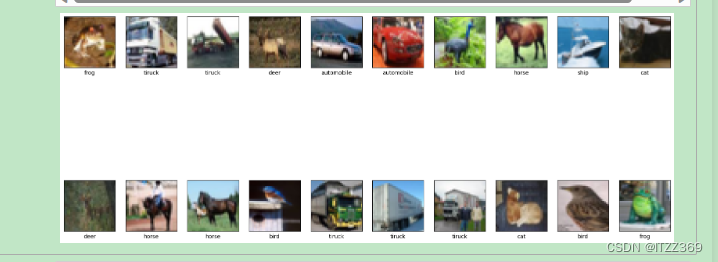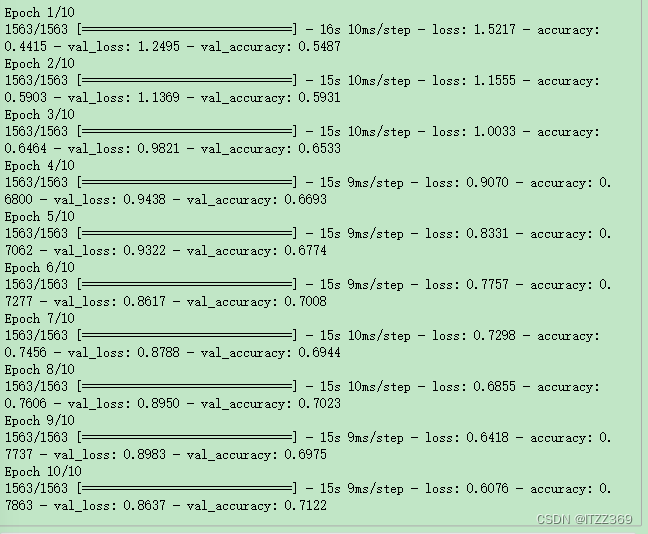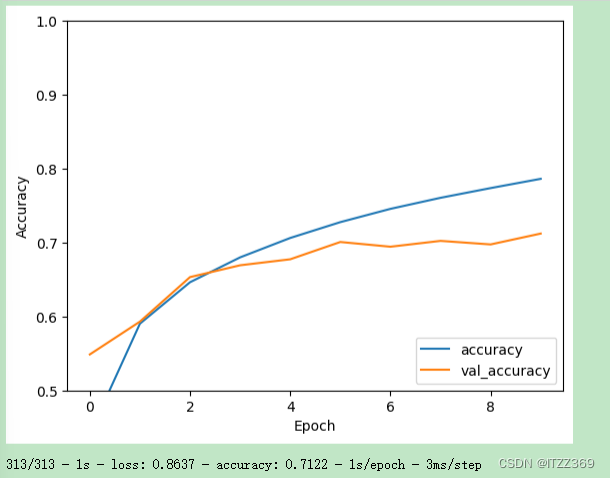- 🍨 本文为🔗365天深度学习训练营 中的学习记录博客
- 🍦 参考文章地址: 🔗深度学习100例-卷积神经网络(CNN)彩色图片分类 | 第2天
- 🍖 作者:K同学啊
🚀 我的环境:
语言环境:Python3.9.0
编译器:jupyter notebook
深度学习环境:TensorFlow2.12.0
- 目录
一、前期工作
2. 设置GPU
3. 导入数据
4. 归一化
5. 可视化
二、构建CNN网络
三、编译
四、训练模型
五、预测
六、模型评估
前期工作
- 设置GPU
import tensorflow as tf
gpus = tf.config.list_physical_devices("GPU")
if gpus:
gpu0 = gpus[0]
tf.config.experimental.set_memory_growth(gpu0,True)
tf.config.set_visible_devices([gpu0],"GPU")
2.导入数据
import tensorflow as tf
from tensorflow.keras import datasets,layers,models
import matplotlib.pyplot as plt
(train_images,train_labels),(test_images,test_labels) = datasets.cifar10.load_data()
#导入数据,数据内容分别是:训练集图片、训练集标签、测试集图片、测试集标签
3.图像数据归一化:
import tensorflow as tf
from tensorflow.keras import datasets,layers,models
import matplotlib.pyplot as plt
(train_images,train_labels),(test_images,test_labels) = datasets.cifar10.load_data()
输出结果:

4.进行训练数据的初步可视化
class_names = ['airplane','automobile','bird','cat','deer','dog','frog','horse','ship','tiruck']
#将数据集前20个图片数据可视化显示
#图像大小:20*10
plt.figure(figsize=(20,10))
for i in range(20):
#将整个figure分成2行10列
plt.subplot(2,10,i+1)
#设置不显示X轴刻度
plt.xticks([])
#设置不显示Y轴刻度
plt.yticks([])
#设置不显示子图网格线
plt.grid(False)
#图像展示,cmap为颜色图谱,“plt.cm.binar”为matplotlib.cm中的色表
plt.imshow(train_images[i],cmap=plt.cm.binary)
#设置X轴标签显示为图片集对应的标签名
plt.xlabel(class_names[train_labels[i][0]])
#显示图片
plt.show()
输出

二、构建CNN模型
#构建CNN网络模型
#创建并设置卷积神经网络
#卷积层、池化层、全连接层
model = models.Sequential([
#设置二维卷积层1,设置32个3*3的卷积核,activation参数将激活函数设置为Relu函数,
#input_shape参数将图层的输入形状设置为(32,32,3)
#Relu函数作为激活函数可以增强判定函数和整个神经网络的非线性特性,而本身并不会改变卷积层
#相比于其他函数来说,Relu函数更受青睐,这是因为它可以将神经网络的训练速度提升数倍,而不会对模型的泛化准确度造成影响。
layers.Conv2D(32,(3,3),activation='relu',input_shape=(32,32,3)),
#池化层1,2*2采样
layers.MaxPooling2D((2,2)),
#设置二维卷积层2,设置64个3*3卷积核,activation参数将激活函数设置为Relu
layers.Conv2D(64,(3,3),activation='relu'),
#池化层2,2*2采样
layers.MaxPooling2D((2,2)),
layers.Conv2D(64,(3,3),activation='relu'),
#Flatten层,连接卷积层与全连接层
layers.Flatten(),
#全连接层,特征进一步提取,64为输出空间的维数,activation参数将激活函数设置为Relu函数
layers.Dense(64,activation='relu'),
#输出层,输出预期结果,10为输出空间的维数
layers.Dense(10)
])
model.summary()
OUT:

编译
#设置优化器、损失函数以及metrics
#model.compile()方法用于在配置训练方法时,告知训练时用的优化器、损失函数和准确率测评标准
model.compile(
#设置优化器为Adam优化器
optimizer='adam',
#设置损失函数为交叉熵损失函数(tf.keras.losses.SparseCategoricalCrossentropy())
#参数:from_logits,为True时,会将y_pred转化为概率(用softmax),否则不进行转换,通常情况下用True更稳定
loss=tf.keras.losses.SparseCategoricalCrossentropy(from_logits=True),
#设置性能指标列表,将在模型训练时监控列表中的指标
metrics=['accuracy']
)
训练模型
#训练模型
history = model.fit(train_images,train_labels,epochs=10,
validation_data=(test_images,test_labels))
训练过程

输出预测的第一张图片结果

模型评估
import matplotlib.pyplot as plt
plt.plot(history.history['accuracy'],label = 'accuracy')
plt.plot(history.history['val_accuracy'],label = 'val_accuracy')
plt.xlabel('Epoch')
plt.ylabel('Accuracy')
plt.ylim([0.5,1])
plt.legend(loc = 'lower right')
plt.show()
test_loss,test_acc = model.evaluate(test_images,test_labels,verbose=2)

思考与总结
1.在进行图像的归一化处理时,输出的结果是什么含义?

2.
本意是分成5行10列,怎么出现的是两行10






















 746
746











 被折叠的 条评论
为什么被折叠?
被折叠的 条评论
为什么被折叠?








